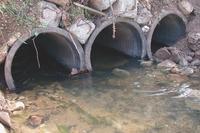Absence of organic waste in water

Xabier Sevillano, researcher at the University of Navarra, has presented his doctoral thesis on a new process of elimination of organic waste in water. A comprehensive study has been conducted to find ways to eliminate phenols, really harmful substances. And why phenols? Despite their easy biodegradation, they are the most common pollutants and are emitted by a multitude of industries. In addition, in spills with high concentrations of phenols, for example, it is very difficult to remove phenols from water. European and Spanish legislation limits the emissions of these products but, however, there are several companies
Therefore, it is very common for water to be contaminated by phenols. In addition, these compounds are often used in laboratory studies. There is a lot of information and bibliography about phenols.
To combat these substances, Xabier Sevillano has designed a bioreactor. The biological reactor is a simple fluid bed reactor, but with a special support, the cyclodextrin beta polymer. In general, this polymer is able to retain aromatic compounds, such as phenols. Always under conditions, retains compounds with greater or lesser affinity. The fluid bed is a system made up of small solid fractions that air keeps in suspension. This improves the mixture between the fractions involved in the process.
This structure also retains and releases other organic compounds as toxic as phenols (polycyclic aromatic compounds, etc. ). Thus, if the biological system is not able to degrade all the polluting residues, some of them are retained in this support. Environmental impacts can be lower as emissions will be reduced. On the contrary, at the time of destabilization of the biological system itself, due to the lack of nutrients, the polymer is able to release previously retained contaminants, stabilizing the system.
Clean and economical system
The method developed by Xabier Sevillano does not generate harmful by-products and, in addition, the bioreactor has two main advantages: it is quite cheap and does not need much space. On the other hand, the test has been carried out in different conditions (flow, concentration of contaminants or treatment times) and it has been proven that the bioreactor is valid for all these situations. In addition, the support has the characteristics of hydrogel, so it is able to absorb large amounts of water.

However, the bioreactor has a number of disadvantages: on the one hand, the support is fragile; on the other, the bioreactor has a low stability to pH acids by deteriorating the structure of the beta cyclodextrin. On the other hand, the most common disadvantage of fluidized beds is the continuous formation of biomass in the support. This latter disadvantage is most evident when using the cyclodextrin beta polymer as a support.
Several trials have been conducted in the laboratory with satisfactory results, but the reactor has not yet been tested with actual wastewater. There may be more problems or not. However, experts believe it will be a promising reactor.
The bioreactor can also be used to remove other compounds present in wastewater. And if you take into account the characteristics of the bioreactor, it is a very suitable application for those industries with little space for the installation of water treatment plants or with a high content of organic pollutants.
The results of this thesis will promote the implementation of clean, economical and efficient water purification processes.





